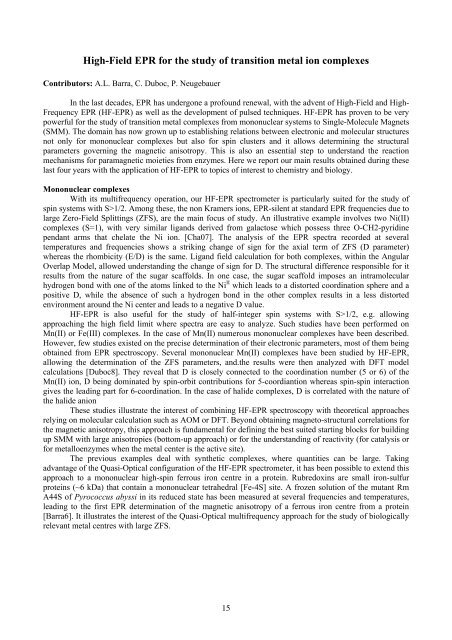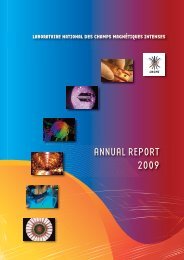Laboratoire National des Champs Magnétiques Pulsés CNRS – INSA
Laboratoire National des Champs Magnétiques Pulsés CNRS – INSA
Laboratoire National des Champs Magnétiques Pulsés CNRS – INSA
Create successful ePaper yourself
Turn your PDF publications into a flip-book with our unique Google optimized e-Paper software.
High-Field EPR for the study of transition metal ion complexes<br />
Contributors: A.L. Barra, C. Duboc, P. Neugebauer<br />
In the last deca<strong>des</strong>, EPR has undergone a profound renewal, with the advent of High-Field and High-<br />
Frequency EPR (HF-EPR) as well as the development of pulsed techniques. HF-EPR has proven to be very<br />
powerful for the study of transition metal complexes from mononuclear systems to Single-Molecule Magnets<br />
(SMM). The domain has now grown up to establishing relations between electronic and molecular structures<br />
not only for mononuclear complexes but also for spin clusters and it allows determining the structural<br />
parameters governing the magnetic anisotropy. This is also an essential step to understand the reaction<br />
mechanisms for paramagnetic moieties from enzymes. Here we report our main results obtained during these<br />
last four years with the application of HF-EPR to topics of interest to chemistry and biology.<br />
Mononuclear complexes<br />
With its multifrequency operation, our HF-EPR spectrometer is particularly suited for the study of<br />
spin systems with S>1/2. Among these, the non Kramers ions, EPR-silent at standard EPR frequencies due to<br />
large Zero-Field Splittings (ZFS), are the main focus of study. An illustrative example involves two Ni(II)<br />
complexes (S=1), with very similar ligands derived from galactose which possess three O-CH2-pyridine<br />
pendant arms that chelate the Ni ion. [Cha07]. The analysis of the EPR spectra recorded at several<br />
temperatures and frequencies shows a striking change of sign for the axial term of ZFS (D parameter)<br />
whereas the rhombicity (E/D) is the same. Ligand field calculation for both complexes, within the Angular<br />
Overlap Model, allowed understanding the change of sign for D. The structural difference responsible for it<br />
results from the nature of the sugar scaffolds. In one case, the sugar scaffold imposes an intramolecular<br />
hydrogen bond with one of the atoms linked to the Ni II which leads to a distorted coordination sphere and a<br />
positive D, while the absence of such a hydrogen bond in the other complex results in a less distorted<br />
environment around the Ni center and leads to a negative D value.<br />
HF-EPR is also useful for the study of half-integer spin systems with S>1/2, e.g. allowing<br />
approaching the high field limit where spectra are easy to analyze. Such studies have been performed on<br />
Mn(II) or Fe(III) complexes. In the case of Mn(II) numerous mononuclear complexes have been <strong>des</strong>cribed.<br />
However, few studies existed on the precise determination of their electronic parameters, most of them being<br />
obtained from EPR spectroscopy. Several mononuclear Mn(II) complexes have been studied by HF-EPR,<br />
allowing the determination of the ZFS parameters, and.the results were then analyzed with DFT model<br />
calculations [Duboc8]. They reveal that D is closely connected to the coordination number (5 or 6) of the<br />
Mn(II) ion, D being dominated by spin-orbit contributions for 5-coordiantion whereas spin-spin interaction<br />
gives the leading part for 6-coordination. In the case of halide complexes, D is correlated with the nature of<br />
the halide anion<br />
These studies illustrate the interest of combining HF-EPR spectroscopy with theoretical approaches<br />
relying on molecular calculation such as AOM or DFT. Beyond obtaining magneto-structural correlations for<br />
the magnetic anisotropy, this approach is fundamental for defining the best suited starting blocks for building<br />
up SMM with large anisotropies (bottom-up approach) or for the understanding of reactivity (for catalysis or<br />
for metalloenzymes when the metal center is the active site).<br />
The previous examples deal with synthetic complexes, where quantities can be large. Taking<br />
advantage of the Quasi-Optical configuration of the HF-EPR spectrometer, it has been possible to extend this<br />
approach to a mononuclear high-spin ferrous iron centre in a protein. Rubredoxins are small iron-sulfur<br />
proteins (~6 kDa) that contain a mononuclear tetrahedral [Fe-4S] site. A frozen solution of the mutant Rm<br />
A44S of Pyrococcus abyssi in its reduced state has been measured at several frequencies and temperatures,<br />
leading to the first EPR determination of the magnetic anisotropy of a ferrous iron centre from a protein<br />
[Barra6]. It illustrates the interest of the Quasi-Optical multifrequency approach for the study of biologically<br />
relevant metal centres with large ZFS.<br />
15







